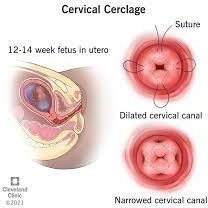A pregnant woman is being discharged from the hospital after the placement of a cervical cerclage because of a history of recurrent pregnancy loss, secondary to an incompetent cervix. Which information regarding postprocedural care should the nurse emphasize in the discharge teaching?
Any vaginal discharge should be immediately reported to her health care provider.
The presence of any contractions, rupture of membranes (ROM), or severe perineal pressure should be reported.
The client will be scheduled for a cesarean birth.
The client will need to arrange for care at home because her activity level will be restricted.
The Correct Answer is B
The information that the nurse should emphasize in the discharge teaching for a pregnant woman who has undergone a cervical cerclage due to an incompetent cervix is that the presence of any contractions, rupture of membranes (ROM), or severe perineal pressure should be reported to her healthcare provider immediately. This is because these symptoms could indicate cervical dilation or premature labor, which can lead to pregnancy loss or other complications.
Reporting any vaginal discharge is important, but it is not the most critical symptom to monitor for after cervical cerclage placement. Vaginal discharge is common after cervical cerclage and can occur for several weeks without posing a significant risk to the pregnancy.
A cesarean birth may or may not be necessary depending on the patient's individual circumstances and the course of the pregnancy. It is not a given that all women with cervical cerclage require a cesarean delivery.
While some activity restrictions may be necessary after cervical cerclage placement, it is not necessary for the patient to arrange for care at home. Many women are able to manage their daily activities with appropriate precautions and guidance from their healthcare provider.

Nursing Test Bank
Naxlex Comprehensive Predictor Exams
Related Questions
Correct Answer is D
Explanation
The biophysical profile (BPP) would yield more detailed information about the fetus in this scenario. The BPP is a prenatal ultrasound evaluation that assesses fetal well-being by evaluating five biophysical variables: fetal breathing movements, fetal movements, fetal tone, amniotic fluid volume, and fetal heart rate. The BPP is a more detailed assessment of fetal well-being compared to a nonstress test and can provide valuable information about the fetus's overall health and well-being, including any potential issues or difficulties.
MSAFP screening is a blood test that can detect certain fetal abnormalities, but it does not provide detailed information about fetal well-being.
Percutaneous umbilical blood sampling (PLBS) is an invasive test that is used to obtain a sample of fetal blood for testing in cases of suspected fetal anemia or other blood disorders. Ultrasound for fetal anomalies is a diagnostic tool used to detect structural abnormalities or defects in the fetus. While it can provide some information about fetal well-being, it is not as comprehensive as the BPP in evaluating fetal health and wellness.
Correct Answer is B
Explanation
The Web of Causation model would be best for studying the complex relationships among factors that contribute to chronic disease. This model recognizes that chronic diseases result from the interplay of multiple factors at different levels, including individual, environmental, and societal factors. The model illustrates the complexity of these relationships and can help identify potential points for intervention.

Whether you are a student looking to ace your exams or a practicing nurse seeking to enhance your expertise , our nursing education contents will empower you with the confidence and competence to make a difference in the lives of patients and become a respected leader in the healthcare field.
Visit Naxlex, invest in your future and unlock endless possibilities with our unparalleled nursing education contents today
Report Wrong Answer on the Current Question
Do you disagree with the answer? If yes, what is your expected answer? Explain.
Kindly be descriptive with the issue you are facing.
